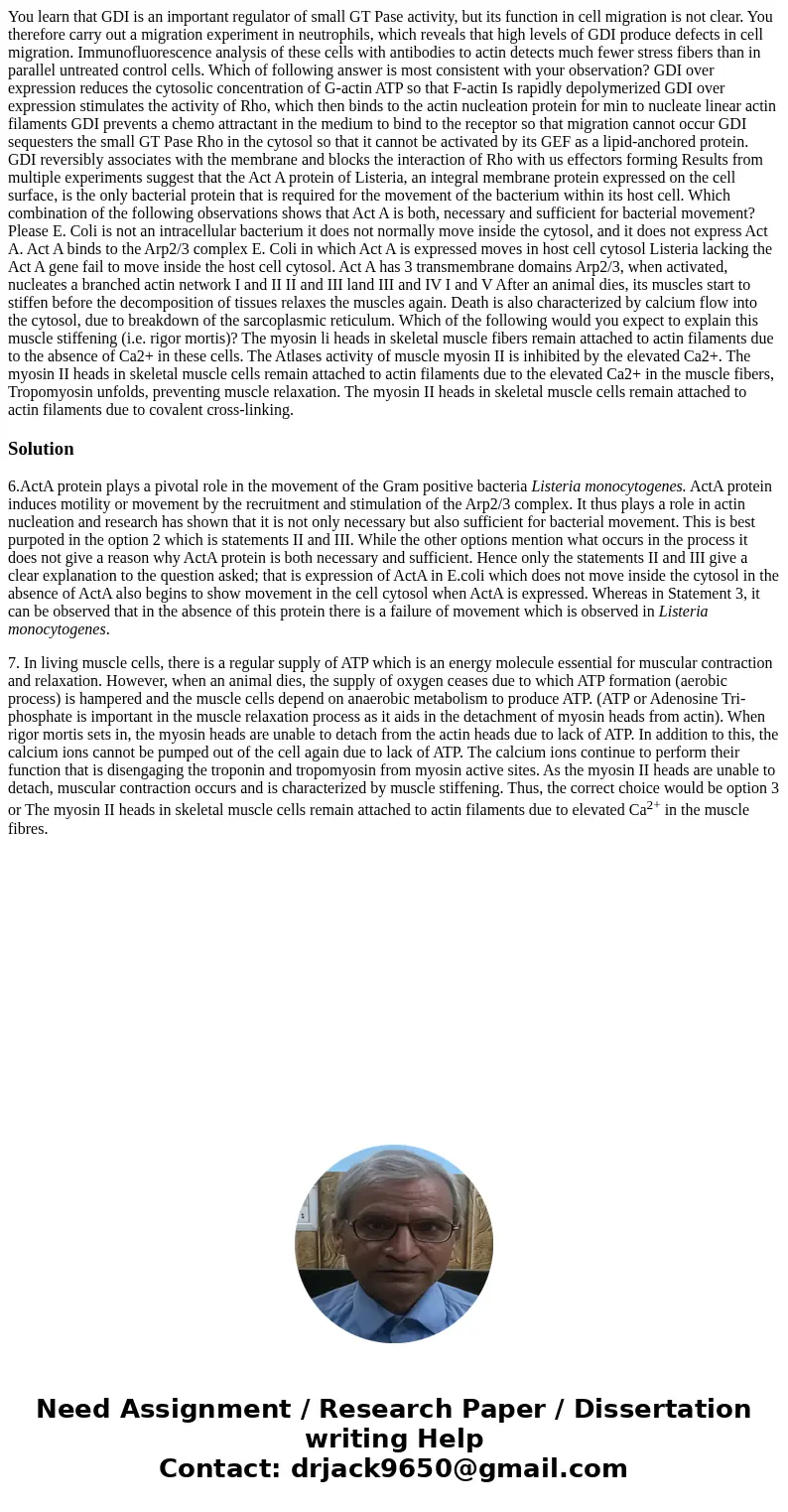You learn that GDI is an important regulator of small GT Pase activity, but its function in cell migration is not clear. You therefore carry out a migration experiment in neutrophils, which reveals that high levels of GDI produce defects in cell migration. Immunofluorescence analysis of these cells with antibodies to actin detects much fewer stress fibers than in parallel untreated control cells. Which of following answer is most consistent with your observation? GDI over expression reduces the cytosolic concentration of G-actin ATP so that F-actin Is rapidly depolymerized GDI over expression stimulates the activity of Rho, which then binds to the actin nucleation protein for min to nucleate linear actin filaments GDI prevents a chemo attractant in the medium to bind to the receptor so that migration cannot occur GDI sequesters the small GT Pase Rho in the cytosol so that it cannot be activated by its GEF as a lipid-anchored protein. GDI reversibly associates with the membrane and blocks the interaction of Rho with us effectors forming Results from multiple experiments suggest that the Act A protein of Listeria, an integral membrane protein expressed on the cell surface, is the only bacterial protein that is required for the movement of the bacterium within its host cell. Which combination of the following observations shows that Act A is both, necessary and sufficient for bacterial movement? Please E. Coli is not an intracellular bacterium it does not normally move inside the cytosol, and it does not express Act A. Act A binds to the Arp2/3 complex E. Coli in which Act A is expressed moves in host cell cytosol Listeria lacking the Act A gene fail to move inside the host cell cytosol. Act A has 3 transmembrane domains Arp2/3, when activated, nucleates a branched actin network I and II II and III land III and IV I and V After an animal dies, its muscles start to stiffen before the decomposition of tissues relaxes the muscles again. Death is also characterized by calcium flow into the cytosol, due to breakdown of the sarcoplasmic reticulum. Which of the following would you expect to explain this muscle stiffening (i.e. rigor mortis)? The myosin li heads in skeletal muscle fibers remain attached to actin filaments due to the absence of Ca2+ in these cells. The Atlases activity of muscle myosin II is inhibited by the elevated Ca2+. The myosin II heads in skeletal muscle cells remain attached to actin filaments due to the elevated Ca2+ in the muscle fibers, Tropomyosin unfolds, preventing muscle relaxation. The myosin II heads in skeletal muscle cells remain attached to actin filaments due to covalent cross-linking.
6.ActA protein plays a pivotal role in the movement of the Gram positive bacteria Listeria monocytogenes. ActA protein induces motility or movement by the recruitment and stimulation of the Arp2/3 complex. It thus plays a role in actin nucleation and research has shown that it is not only necessary but also sufficient for bacterial movement. This is best purpoted in the option 2 which is statements II and III. While the other options mention what occurs in the process it does not give a reason why ActA protein is both necessary and sufficient. Hence only the statements II and III give a clear explanation to the question asked; that is expression of ActA in E.coli which does not move inside the cytosol in the absence of ActA also begins to show movement in the cell cytosol when ActA is expressed. Whereas in Statement 3, it can be observed that in the absence of this protein there is a failure of movement which is observed in Listeria monocytogenes.
7. In living muscle cells, there is a regular supply of ATP which is an energy molecule essential for muscular contraction and relaxation. However, when an animal dies, the supply of oxygen ceases due to which ATP formation (aerobic process) is hampered and the muscle cells depend on anaerobic metabolism to produce ATP. (ATP or Adenosine Tri-phosphate is important in the muscle relaxation process as it aids in the detachment of myosin heads from actin). When rigor mortis sets in, the myosin heads are unable to detach from the actin heads due to lack of ATP. In addition to this, the calcium ions cannot be pumped out of the cell again due to lack of ATP. The calcium ions continue to perform their function that is disengaging the troponin and tropomyosin from myosin active sites. As the myosin II heads are unable to detach, muscular contraction occurs and is characterized by muscle stiffening. Thus, the correct choice would be option 3 or The myosin II heads in skeletal muscle cells remain attached to actin filaments due to elevated Ca2+ in the muscle fibres.

 Homework Sourse
Homework Sourse